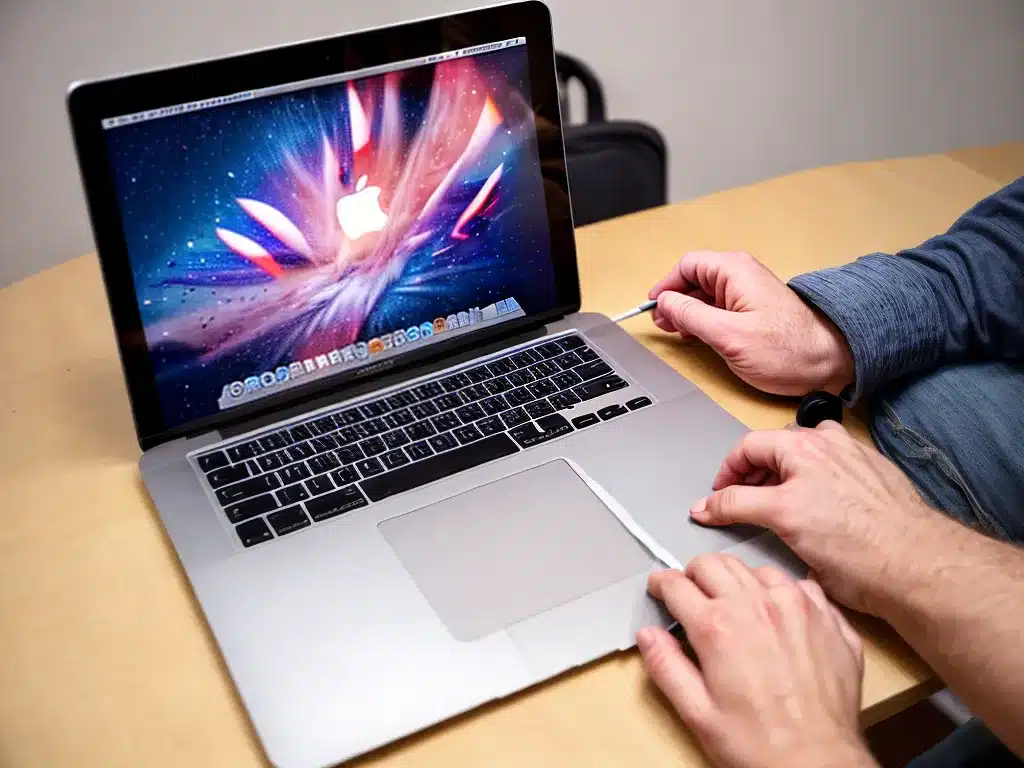
Clean the Screen and Keyboard
Keeping your MacBook’s screen and keyboard clean is important for functionality and aesthetics. Here are some tips:
-
Use a microfiber cloth to gently wipe dust and fingerprints off the screen. Microfiber traps particles without scratching. Avoid using tissues or paper towels as they can leave lint.
-
Do not use window cleaner on the screen, as it can damage the coating. Use a display cleaning solution made specifically for screens, or mix equal parts water and white vinegar.
-
For the keyboard, turn it upside down and gently shake out any debris. You can also use compressed air to blow out particles lodged between the keys. Avoid getting moisture in the keyboard.
-
Wipe down the outer case with a microfiber cloth dampened slightly with water or a mild cleaner to remove accumulated dirt and oils from your hands.
Update Software and Drivers
Keeping your software up to date ensures your MacBook has the latest features, security enhancements, and bug fixes.
-
Open the App Store app and click ‘Updates’ to install any available updates for macOS and Apple apps.
-
For non-App Store apps, check the developer’s website for updates. Many apps have an auto-update function you can enable.
-
Go to System Preferences > Software Update to check for macOS updates. These can improve performance and fix security vulnerabilities, so it’s important to install them.
-
Check for updated drivers from the manufacturers of any peripherals you use, such as printers and external displays. Outdated drivers can cause connectivity or performance issues.
Reset the SMC and PRAM
Resetting these firmware systems can fix many common issues like battery problems, trackpad/keyboard errors, and performance lags.
-
To reset SMC: Shut down and unplug MacBook. Press and hold left Shift-Control-Option and the power button for 10 seconds. Release, then turn MacBook back on.
-
To reset PRAM: Shut down MacBook. Turn it on and immediately press Command-Option-P-R. Hold until you hear the startup sound a second time.
Check and Optimize Storage
Running low on storage space can slow down your MacBook and keep you from installing updates.
-
Go to Apple menu > About this Mac > Storage to see disk usage and optimize storage.
-
Empty trash and delete unused apps, files, and caches. Photos and videos take up a lot of space, so delete ones you don’t need and store the rest on an external drive.
-
Use cloud storage for files you access infrequently. Back up important files.
-
Upgrade internal SSD if needed for more storage capacity. An Apple Certified Technician can do this safely.
Check Battery Health
Battery capacity decreases over time, so it’s good to check its status occasionally.
-
Go to Apple menu > System Preferences > Battery and look at Battery Condition. If it says “Service Recommended,” the battery needs to be replaced.
-
Check the cycle count (charges). Apple batteries can handle ~1000 cycles before needing replacement.
-
Calibrate the battery occasionally by fully charging, fully discharging, and recharging again. This syncs the battery percentage with actual capacity.
-
Dim screen brightness, turn off keyboard backlight, and quit intensive apps to conserve battery life. Close apps and lid when not using MacBook.
Performing basic maintenance keeps your MacBook running smoothly for years. Following these tips helps optimize performance, extend battery life, and prevent issues.












